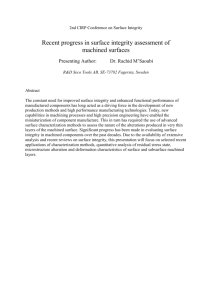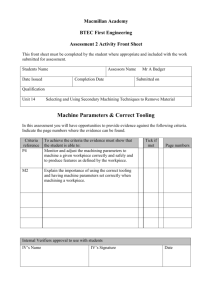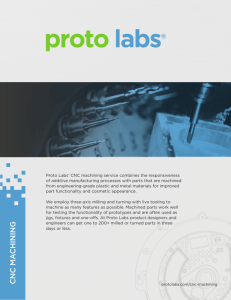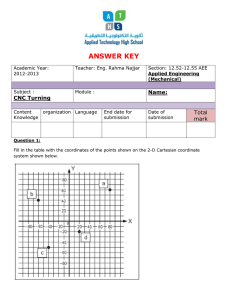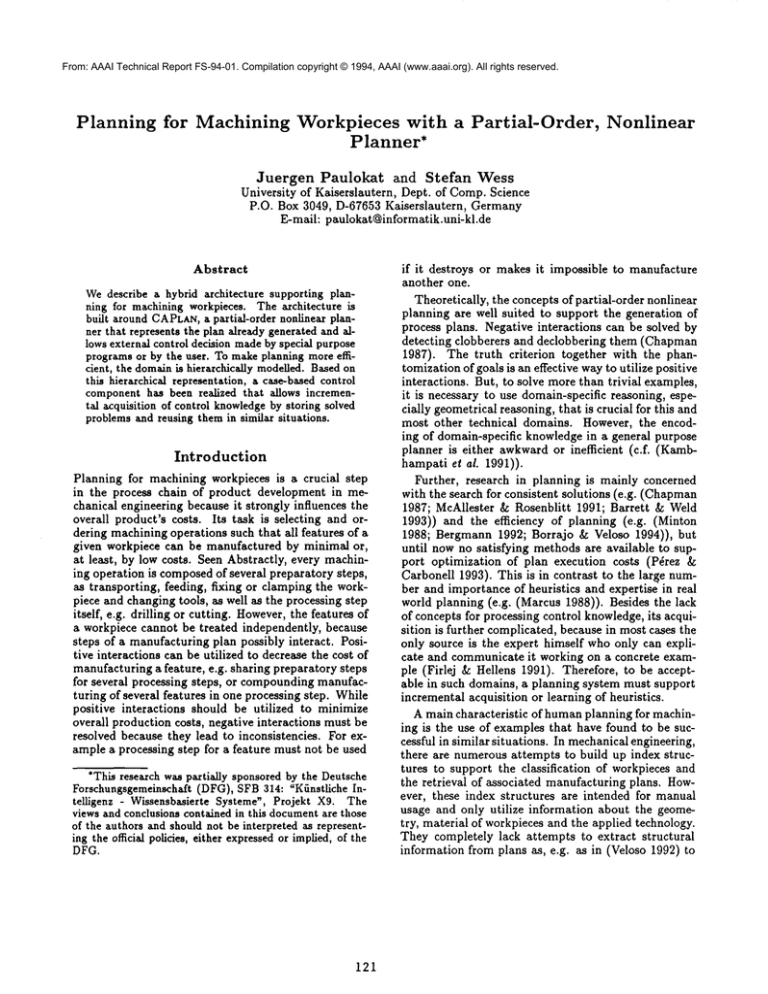
From: AAAI Technical Report FS-94-01. Compilation copyright © 1994, AAAI (www.aaai.org). All rights reserved.
Planning
for Machining Workpieces with a Partial-Order,
Planner*
Nonlinear
Juergen
Paulokat
and Stefan
Wess
University of Kaiserslautern, Dept. of Comp.Science
P.O. Box 3049, D-67653 Kaiserslautern,
Germany
E-mail: paulokat @informatik.uni-kl.de
Abstract
Wedescribe a hybrid architecture supporting planning for machining workpieces. The architecture is
built around CAPLAN,
a partial-order nonlinear planner that represents the plan already generated and allows external control decision madeby special purpose
programsor by the user. To makeplanning moreefficient, the domainis hierarchically modelled.Basedon
this hierarchical representation, a case-based control
componenthas been realized that allows incremental acquisition of control knowledgeby storing solved
problemsand reusing themin similar situations.
Introduction
Planning for machining workpieces is a crucial step
in the process chain of product development in mechanical engineering because it strongly influences the
overall product’s costs. Its task is selecting and ordering machining operations such that all features of a
given workpiece can be manufactured by minimal or,
at least, by low costs. Seen Abstractly, every machining operation is composedof several preparatory steps,
as transporting, feeding, fixing or clamping the workpiece and changing tools, as well as the processing step
itself, e.g. drilling or cutting. However,the features of
a workpiece cannot be treated independently, because
steps of a manufacturing plan possibly interact. Positive interactions can be utilized to decrease the cost of
manufacturing a feature, e.g. sharing preparatory steps
for several processing steps, or compoundingmanufacturing of several features in one processing step. While
positive interactions should be utilized to minimize
overall production costs, negative interactions must be
resolved because they lead to inconsistencies. For example a processing step for a feature must not be used
"This research was partiMly sponsored by the Deutsche
Forschungsgemeinschaft (DFG), SFB314: "K6nstliche Intelligenz - Wissensbasierte Systeme’, Projekt X9. The
views and conclusions contained in this documentare those
of the authors and should not be interpreted as representing the official policies, either expressedor implied, of the
DFG.
121
if it destroys or makes it impossible to manufacture
another one.
Theoretically, the concepts of partial-order nonlinear
planning are well suited to support the generation of
process plans. Negative interactions can be solved by
detecting clobberers and declobbering them (Chapman
1987). The truth criterion together with the phantomization of goals is an effective wayto utilize positive
interactions. But, to solve more than trivial examples,
it is necessary to use domain-specific reasoning, especially geometrical reasoning, that is crucial for this and
most other technical domains. However, the encoding of domain-specific knowledgein a general purpose
planner is either awkwardor inefficient (c.f. (Kambhampati el al. 1991)).
Further, research in planning is mainly concerned
with the search for consistent solutions (e.g. (Chapman
1987; McAllester & Rosenblitt 1991; Barrett & Weld
1993)) and the efficiency of planning (e.g. (Minton
1988; Bergmann 1992; Borrajo & Veloso 1994)), but
until now no satisfying methods are available to support optimization of plan execution costs (P~rez
Carbonell 1993). This is in contrast to the large number and importance of heuristics and expertise in real
world planning (e.g. (Marcus 1988)). Besides the
of concepts for processing control knowledge,its acquisition is further complicated, because in most cases the
only source is the expert himself who only can explicate and communicate it working on a concrete example (Firlej & Hellens 1991). Therefore, to be acceptable in such domains, a planning system must support
incremental acquisition or learning of heuristics.
A main characteristic of humanplanning for machining is the use of examples that have found to be successful in similar situations. In mechanicalengineering,
there are numerous attempts to build up index structures to support the classification of workpieces and
the retrieval of associated manufacturing plans. However, these index structures are intended for manual
usage and only utilize information about the geometry, material of workpieces and the applied technology.
They completely lack attempts to extract structural
information from plans as, e.g. as in (Veloso 1992)
make retrieval more informed.
In this paper, we describe a prototypical system
for supporting planning for machining, that is implemented using CAPLAN,
a nonlinear, partial-order general purpose planner. Because of the impossibility to
acquire complete control knowledge and the lack of
concepts for deep domain-specific reasoning, CAPLAN
is organized as a planning assistant that has a partial
model of domain-specific control knowledge and that
sl/stematically searches if no control knowledgeis available. To complete the represented domain knowledge,
the user can revise all planning decisions at every moment and can interactively control plan generation. In
this case, the task of the planner is to represent external control decisions and to computetheir effects in
the overall plan. To support incremental acquisition
and usage of episodic knowledge, the planning process
can be additionally controlled by replaying a case that
is a machining plan interactively developed with the
system and kept in a case base. Replay is made by
CAPLAN/CBC
that utilizes the user interface of CAPLANto guide its search by the decisions represented
in a case.
A-17,1, ~ A-17,.~
[1ram
3Q
IS
0
-15
-30
Figure 1: Geometrical representation
and the cylindrical raw material.
of a workpiece
The Domain Characteristics
The domain we are concerned with is manufacturing
planning for rotary-symmetrical workpieces to be machined on a lathe. A planning problem is given as
a geometrical description of a workpiece and of the
raw material that only can be cylindrical in our model
(Fig. 1). The description of a workpiece is built
from geometrical primitives as cylinders, cones and
toroids that describe monotone areas of the outline,
possibly augmented by features as threads, grooves or
special surface conditions. In most cases, the outline
of a workpiece cannot be machined in one step, but
repeated cutting operations are necessary to cut the
difference between the raw material and the workpiece
in thin horizontal or vertical layers. These layers are
built up from atomic processing areas, that are automatically generated by extending the horizontal and
vertical bounding lines of the geometrical primitives.
Cutting an atomic area can be seen as an elementary
cutting step.
For machining, the workpiece is clamped by a rotating clamping tool, while layers of material are removed
by moving a cutting tool along its surface. Standard
tools that are normally used for machining large areas
have a fixed working direction, i.e., they only can be
used to cut off material whenbeing movedeither to the
left or to the right. Clamping a workpiece hides parts
of its surface, therefore, after machining the part not
hidden, it must be turned and clamped on the other
side. Additonally, caused by the geometry of standard
cutting tools only horizontal outlines or outlines that
are rising along a tool’s moving direction can be machined. To machine a descending outline requires tool
changes which increase the overall production costs.
122
Figure 2: Geometrical representation
ing planning problem.
of a manufactur-
But after turning a workpiece and clamping it from
the ohter side, e.g. necessary for machining an area
hidden by a clamping tool, a descending outline becomes a rising one and can be machined with the same
tool. For finding maximally monotonously rising areas, geometrical primitives are grouped to rising areas
at both ends of the workpiece and a horizontal area
between them (Fig. 2). Each of these compound areas can contain subareas that break the monotonous
course of the outline. But from an abstract point of
view they do not influence the construction because
the monotonousoutline necessarily has to be machined
first before hidden subareas can be machined. For machining, the horizontal part can be added consistently
to one of both rising areas, but choosing an alternative
is one of the tasks of the planner because this choice
can influence the plan’s execution costs. Compound
areas can be degenerated to consist of only one geometric primitive, e.g. the horizontal area in Fig. 2.
These areas can be seen as an abstract description of
the workpiece resulting in a hierarchical representation
whose root node represents the whole workpiece with
conservative (Kambhampatiet al. 1991) modifications
of the current plan. The R~.DUXontology is a general
framework supporting decision making and the retraction of decisions. It supports the representation of rationals for the validity, admissibility and optimality of
a decision as well as for its rejection. Every rejection
describes planning situations in which the according
decision is not allowed. The rationals are stored as
justifications
in a TMSnetwork and are automatically
supervised by TMSconsistency techniques.
Conservative modification of a plan is supported
by storing planning decisions in an explicit AND/OR
search tree. This is in contrast to manyother planning
systems where they are kept in pure chronological order. So, the retraction of an early decision only forces
the retraction of causally dependent decisions but does
not influence any other decisions made chronologically
later.
Figure3: Hierarchical
representation
of a planning
problem.
thecompound
areasas successors
(Fig.3).Theirsuccessors
arethegeometrical
primitives
andthesubareas
of theworkpiece.
A geometrical
primitive
hassuccessornodesforitsfeatures
andtheatomic
processing
areasthatarelocated
aboveit.Subareas,
again,canbe
hierarchically
structured,
defining
theirownsubtrees.
Thishierarchical
representation
of theworkpiece
isthe
basefora hierarchically
structured
planning
process.
The Planning
Assistant
CAPIan
Beforewe describe
themodelof theplanning
process
formachining
workpieces,
we givea shortsummaryof
the CAPLAN system.
CAPLANis a domain-independent
nonlinear
partialorder planningsystemimplementedbasedon the
SNLPalgorithm
(McAllester
& Rosenblitt
1991;Barrett & Weld 1993).Althoughit can autonomously
solveproblems
by depth-first
search,
it is mainlyintendedas a planning
assistant
thatprovides
a control
interface
fora humanplanner
or external
control
components,such as CAPLAN/CBCthat implementsa
replaymechanism
forcases.So,everydecision
in a
planning
cyclecanbe madeinteractively.
Thesedecisionsarechoosing
a goalto workonnext,selecting
an
operator
toreduce
orsatisfy
a goal,adding
constraints
to resolve
threats
of causallinksandretracting
operators
to resolve
inconsistent
plansby backtracking.
Usedas a planning
assistant,
CAPLANaddsexternal
decisions
toitspartial
plan,computes
theireffects
and
signals
resulting
threats
orinconsistencies.
In CAPLAN,the conceptsof REDUX(Petrie1991)
are usedto supportuserinteractions
by minimalor
123
Planning
for Machining
Workpieces
The central idea behind our approach is that the planning system has a complete model of all steps in the
domainand a partial collection of control heuristics.
Control knowledge can be represented internally by
control rules or externally by the user or a sophisticated program, e.g. a simulation component or a geometrical reasoner. Such an external control agent is
provided with the set of alternative decisions of a decision point, the information of the workpiece model
and of the current plan. It selects one alternative and
optionally provides rationals for its decisions that are
processed by the underlying REDUXsystem. So, we
can integrate domain-specific reasoning without being
forced to code the knowledge completely into the operators’ description.
machine(
faceI
machined(
fcm~mo
I
m~md(rising-I
) ~mtc.hined(fegmm-2)
m ac./~
feature-3
)
machined(
horizoru[
/ m~.d(~ba~)
ma~(feature-4 )
~
machined(rising-2 ) " : machined(festa’e-5
~
m~:J~ed(
feature.6
)
machined(
face-2
Figure 4: Set of initial
tions.
"~machined(
feature
7
goals and their ordering rela-
Planning for machining a workpiece is preceded by
transforming the abstract level of the hierarchical description of the workpiece Fig. 3) in a problem representation based on propositional logic that is used by
(¢lsmp-wRh-jsw(
--
;-
m
?JAW o.N...u.~...,
)~
-
-,
............
-
clamped(wp
""~machine(
)
)
nsma-l)~:=~
......
machined(
nsms-I
,, ~,^R~-2)
’,
do .....................
.%
: machtned(?AREA-l)
~ !ma~ine(horizontal)]
T .............
!
!’ ?AREA = rising-1
|..mmmmmm~mmmmm|
~ combine( horizon.l
’~
) }’:::~.
horizontal
r~chincd(
)
’Constraints:
.......................
{’ fi’ee(ho,’/zon~)
’i
Conmraim.:
connected( ?AREAhorizontal
......................
)
Figure 5: Partial plan on the abstract planning level.
tool-~
~rOOL)
(cut-~cut-h(
level-l,l
Figure 6: Partial planon the concrete planning level for the abstract operator machine(rising-i) of Fig.
the planner. This analysis step extracts a set of planning goals as well as a set of geometrical and technological constraints, e.g. the technological requirement
that a groove can only be machinedif the outline which
it is contained in, has been already machined. These
constraints are represented by ordering relations between goals representing the planning problem (Fig.
4). In classical planning, orderings are only defined between steps. In this sense the orderings between goals
are used to imply orderings between the subplans to
reach these goals. The effect of these orderings is that
the size of the search space can be significantly reduced
without any further reasoning or representation effort,
because processing of these constraints is completely
done by the analysis step and by internal consistency
mechanisms of the planner. Names, as rising-1 used
in the problem description, provide a link to the geometrical representation. They can be used to access
further information not explicitly represented in the
problem description but which are necessary for control decisions.
124
Figure5 shows a part of the plan on the abstract
planning
levelof thehierarchical
planning
process.First,the plannerdecidedto workon goal
machined(rising-I). Therefore, the abstract operator
machine(rising-I) is selected, which introduces subgoals
to clamp the workpiece and to force the area rising-1
to be free. Then, planning continues with the goal
machined(horlzontal). Here, the planner can choose
between introducing a new step to machine the horizontal component isolated from any other compound
component or to utilize the side effects of another
plan step. In this example the side effect of step
machlne(rising-1) is used. This is supported by the
rule combine(horizontal) that introduces a goal that
connected area is machined. (Note: these rules are
different from control rules; they are comparable to
operators but do not represent actions and are not
part of the resulting process plan.) The new goal machined(?AREA)can be matched to one of the goals
the initial problemdescription and can be statisfied by
a phantomization. As different phantomizations are
possible,
thisisa decision
pointthatcanstrongly
influence
theexecution
costsof theplan.
By thisphantomization,
a decision
is madethatthe
compound
areasrising-1
andhorizontal
are processed
by onestep.Thisinfluences
theexpansion
of theabstractplanstepmachine(rlsing-1)
intoa newplanning
problemon theconcrete
planning
level(Fig.6).Depending
on thisdecision,
thenewplanning
problem
is
to select
andto ordercutting
operations
fortheatomic
processing areas of the compoundareas rising-1 and
horizontal.
Case-basedPlanning
Planning
in CAPLANis doneby depth-first
searchor
guidedby userinteractions.
A userinteraction
plays
theroleof control
knowledge
to finda planwithlow
execution
costs.To improve
thebehavior
of theplannerincrementally,
a partial
or complete
solution
can
be storedas a case,thatconsists
of thehierarchical
problem
description
as wellas of theplanning
decisionsandtheirrationals.
Thisoffers
an opportunity
to
addcontrolknowledge
to the systemand to increase
itsplanning
expertise
because
a casepossibly
contains
userinteractions
thatcomplement
theinsufficiencies
of
themodel.
In thecurrent
implementation,
caseretrieval
is made
by comparing
the hierarchical
description
of a new
problem
withtheproblem
descriptions
of storedcases.
Usingthetree-based
problem
representation
thecase
matchis realizedby treematching.
The similarity
measureis computedas weightedsum of all adding
anddeleting
operations
necessary
fortransforming
the
hierarchical
problem
description
ofthecaseintothedescription
of thecurrent
problem.
Everytransformation
stepis associated
withspecific
costs.
A casequalifies
forsolving
a newproblemif thecomputed
measureis
greater
thana givenlimit.
If thereis a casematching
thecurrent
problem,
the
decisions
of its planare replayedby CAPLAN/CBC,
thatusestheuserinterface
of CAPLANto control
the
planning
process.
Buta planning
decision
of thecase
isonlyreused
if itsrationals
arecompatible
withthe
problemdescription
of the newproblem.Therefore,
mostproblemscan onlybe solvedpartially
by case
replaysuchthatthe partialsolutionmustbe completed
by first-principle
planning.
Because
bothfirstprinciple
planning
and case-based
planning
use the
sameplanner,
allreplayed
planning
decisions
canbe
retracted
during
thecompletion
ofa partial
solution.
Discussion
Wehave described a hybrid planning architecture for
supporting planning for machining workpieces. A main
characteristic of this domainis that planning is driven
by minimizing plan execution costs. Humanplanners
use a large number of heuristics and domain specific
reasoning but their usage is not sufficiently supported
by known planning techniques. Therefore, we support
125
classical planning by extensive preprocessing to unburden the planner as far as possible from domainspecific
reasoning. To overcome the remaining gap we give the
user control over the planning process that makes necessary the storage of decision rationals for supporting
conservative plan changes.
A further main problem is the incremental acquisition of control knowledge. Currently, it is supported
by storing
complete
solutions
as cases. Caseretrieval
is
guidedby theproblemdescription
only,without
considering
therelevance
of features
fortheassociated
plan.Nevertheless,
it seemsto be a basisforfuture
workon incremental
elicitation
andlearning
of domain
specific
control
knowledge
foroptimizing
plans.
References
Barrett,A., and Weld,D. S. 1993.Partial-order
planning. Artificial Intelligence.
Bergmann, R. 1992. Learning abstract plans to speed
up hierarchical planning. In Tadepalli, P., ed., Proceedings of Workshop "Knowledge Compilation and
Speedup Learning" at the Machine Learning Conference. Scotland: University of Aberdeen.
Borrajo, D., and Veloso, M. 1994. Incremental learning of control knowledge for nonlinear problem solving. In Proceedings of the European Conference on
Machine Learning.
Chapman, D. 1987. Planning for Conjunctive Goals.
Artificial Intelligence 32:333-377.
Firlej, M., and Hellens, D. 1991. KnowledgeElicita.
tion -- A Practical Handbook. Prentice Hall.
Kambhampati, S.; Cutkosky, M.; Tenenbaum, M.;
and Lee, S. H. 1991. Combiningspecialized reasoners
and general purpose planners: A case study. In Proceedings of AAAI-91. Menlo Park, California: MIT
Press.
Marcus, S. 1988. Automating Knowledge Acquisition
for Expert Systems. Kluwer Academic Publishers.
McAllester, D., and Rosenblitt, D. 1991. Systematic nonlinear planning. In Proceedings of AAA[-91.
Menlo Park, California: MIT Press.
Minton, S. 1988. Learning Search Control Knowledge
-- An Ezplanation-Based
Approach. Kluwer Academic Publishers.
Pdrez, M. A., and Carbonell, J. 1993. Automated acquisition of control knowledgeto improve the quality
of plans. Technical Report CMU-CS-93-142,School of
ComputerScience, Carnegie Mellon University, Pittsburgh, PA 15213.
Petrie, C. 1991. Context Maintenance. In Proceedings
of AAAI-91. Menlo Park, California: MIT Press.
Veloso, M. M. 1992. Learning by Analogical Reasoning in General Problem Solving. CMU-CS-92-174,
School of ComputerScience, Carnegie Mellon University, Pittsburgh, PA15213.

